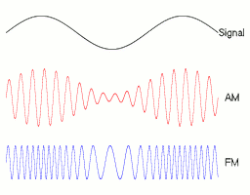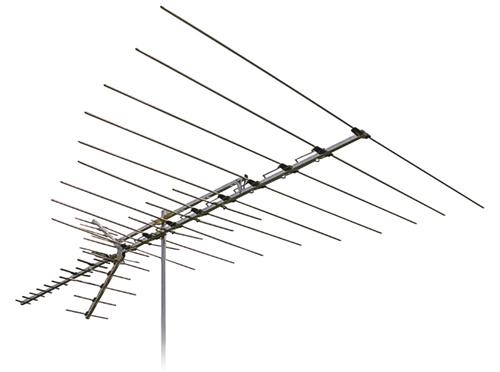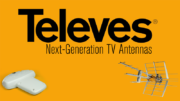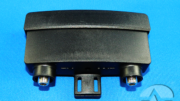One of the simple facts of television antennas is, “bigger is better.” There are a few tweaks you can make to that rule, but in the end you’re going to get better results with a large outdoor antenna than you will with a smaller one. You may be close enough to the towers that it doesn’t make a difference, but that doesn’t change the facts. You’ll get more signal coming through a large antenna.
It comes down to basic antenna design
Did you ever wonder about the difference between an antenna and a piece of bare metal? Did you ever wonder why a flagpole isn’t as good at getting TV signals as a purpose-built antenna? It comes down to two specific properties of antennas.
Size matters. Precise size matters precisely.
The whole idea of broadcasting comes down to the idea that little changes can be made to an electric current as it’s sent through the air. Every electric current has a frequency attached to it. The current flows at a predictable rate. For example, in US electrical circuits, it flows at a rate of 60 cycles per second. We also call this 60 hertz.
Broadcasting takes place at much higher frequencies. An audio or video signal is added to an electrical current and the results look something like this:

AM signals vary in height, while FM signals vary in frequency. But that’s not important right now. What is important is that every frequency corresponds to a particular size wave. As the frequency goes up, the wave gets smaller.
This is important because when we define an “antenna” as opposed to a “big pole.” Antennas receive signal, or so we say. They don’t actively pull signals out of the air although we sometimes say that. What happens is that the antenna conducts the electricity coming through the air better than the air itself does.
An antenna will receive signals most efficiently when they are the same exact size as the wave they receive. If the wave is three feet long, the antenna should be three feet long. Simple as that. Or so you’d think.
Here’s why antennas aren’t always huge.
Your typical 1950’s style antenna looks like this.
In this antenna, each one of those long horizontal rods picks up a different frequency. Each one is exactly the size it needs to be in order to work. However, that doesn’t explain an antenna that looks like this.
We know, for example, that in order to get channel 7, we need an antenna about 6 feet long. But this antenna isn’t 6 feet long.
The trick is, that instead of using the full length of the antenna, you can use an “even fraction.” In other words, a half, a quarter, an eighth, et cetera. These fractional antennas don’t work as well as a full-length antenna, but they work better than some random length.
The mystique of the “quarter wave dipole”
“Quarter wave dipole” is a term we use for an antenna that’s a quarter of the length of the wave that it’s receiving. We generally consider this the smallest that an antenna can be and still be effective. While I haven’t cracked open that Antop antenna you see above, I bet it has a quarter-wave dipole in it of some sort.
The problem is, a quarter wave dipole isn’t ever going to be as good at receiving signal as a full wave dipole. That big spindly antenna has big, full wave dipoles on it and they do a great job of receiving.
Yeah but what about…
People familiar with antennas are going to point out two things, so I may as well point them out first.
VHF vs. UHF
An antenna that’s designed for UHF is going to be smaller than one for VHF. An antenna that’s only designed to get channels 7-13, where most VHF stations are, is going to be smaller than one designed for channels 2-13. It’s obvious why. The antenna you need to pick up channel 2 properly is about 15 feet wide. The antenna you need to get the same reception with channel 36 is about 20 inches wide. (Keep in mind these are the full-wave numbers.) So yes, if you only want UHF frequencies, a small antenna is going to work quite well. The problem is that most areas have at least one VHF station. It might not be one you care about, but it’s there.
Don’t amplifiers make small antennas work as well as large ones?
That’s the claim. Everyone makes it. Heck, even Solid Signal says so. But there’s always something you need to remember. A clean, powerful amplifier is going to allow more signal to get to your TV’s tuner. That’s the goal of every antenna. But, if the signal is so weak that your small antenna doesn’t pick it up, the amplifier has nothing to amplify.
Amplifiers will work fairly well in mid-range situations but with longer distances, a bigger antenna is going to work better, period.
There ain’t no substitute…
In old Detroit, near Solid Signal’s headquarters, they had a saying. “There ain’t no substitute for cubic inches,” they’d say. The idea was you could put all sorts of fancy gadgets on an engine, but nothing would take the place of a nice, big engine.
That may have been true in the 1950s. Today of course we have cars with fairly small engines that outperform huge engines of the past. And we have electric cars that have no engine whatsoever. So it turns out when it comes to engines, there is a substitute. But when it comes to antennas, there’s still no substitute for a larger one. Fancy amplifiers can help a lot, but when you’re trying to pull in a distant station, that big antenna will just do it better. Now, thanks to this article, you know why.







